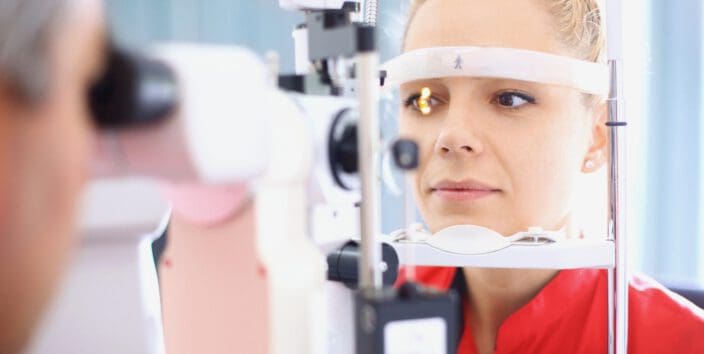COVID-19 Omicron Variant and Eyes
Home / Eye Health and Preventive Care /
Last Updated:
Table of Contents
As of February 2022, there were more than 200,000 reported cases of COVID-19 Omicron variant in the United States.
The World Health Organization (WHO) on January 6, 2022, cautioned against classifying Omicron as mild. At a media briefing, the organization’s Director General said that the latest variant is still causing hospitalizations and death, just like its predecessors.
Existing COVID vaccines should combat Omicron, although it’s not clear how effective they are in preventing re-infections. Thousands of Americans who were vaccinated and also received a booster shot nonetheless contracted one variant of COVID.
There’s little data on the latest COVID mutant so far. As such, most of the information available on its symptoms and different characteristics from previous variants like Delta is largely inconclusive.
Some patients in the reported Omicron cases so far have experienced symptoms similar to those of previous COVID infections.
Unlike some earlier mutants, Omicron hasn’t caused any known eye or vision problems to date.
COVID-19 and the Eyes
According to some studies, one in every three patients with certain COVID variants experienced eye-related complications. There isn’t enough data to conclude whether the Delta variant causes similar vision issues.
Conjunctivitis, also known as pink eye, is one of the eye conditions associated with COVID-19. Its symptoms include:
You deserve clear vision. We can help.
With 135+ locations and over 2.5 million procedures performed, our board-certified eye surgeons deliver results you can trust.
Your journey to better vision starts here.

- Bloodshot eyes
- Eye irritation
- Eye soreness
- Eyelid inflammation (swelling)
- Tearing
- Sensation of a foreign object in the eye
In one case, a 46-year-old man with respiratory problems developed pink eye five days after testing positive for COVID-19. He recovered in a month after treatment with topical antibiotics.
Other eye disorders reported as COVID symptoms include:
- Corneal damage
- Optic nerve changes
- Retina issues
- Swollen eyes (uveitis)
If untreated, most of the issues can cause serious vision problems, including complete loss of eyesight.
Regardless of variant, COVID can transmit through contact with the eyes. For example, you could catch the infection after rubbing your eyes with infected hands.
Although the virus has been detected in tears, there’s no general consensus on the possibility of tears transmitting the infection. Some researchers believe that any such risk would be significantly small.
Does the Omicron Variant Affect Your Eyes?
There isn’t enough data to tell how Omicron might impact your eyes and vision. The variant might differ from other variants in a few ways.
While previous mutations were reported to cause loss of taste and smell, people who contracted the Omicron variant have not reported those symptoms as primary. Sneezing, coughing and chest congestion are among the primary symptoms. Many people infected with Omicron reported that they did not feel like they had COVID. Instead, they said, they felt as if they were battling a sinus infection.
The newest COVID variant shares symptoms like those reported with other variants, including:
- Nausea
- Gastrointestinal issues
- Fatigue
- Headaches
- Body aches
- Fever
- Difficulty breathing
- Coughing
- Flu-like symptoms
Omicron also seems to have a shorter incubation period than other known variants. You could develop Omicron symptoms within three days after being infected. Variants like Delta have a four- to six-day incubation period.
MIS-C in Children a Concern: Know the Symptoms
Since the onset of the pandemic, Multisystem Inflammatory Syndrome (MIS-C) has affected children in ways that puzzle researchers. Doctors have yet to determine what causes the condition other than it is directly related to COVID: 98 percent of patients with MIS-C also had COVID.
The Centers for Disease Control and Infection (CDC) reported 6,431 cases of MIS-C as of January 3, 2022. Nationwide, 55 kids have died from it.
The disease can cause different parts of the body to swell. It can affect organs like the heart, eyes, brain, and kidneys.
MIS-C patients may experience symptoms like:
- Red eyes
- Diarrhea
- Lightheadedness
- Nausea/vomiting
- Confusion
- Hypersomnia (difficulty waking up or staying awake)
- Chest pain
You deserve clear vision. We can help.
With 135+ locations and over 2.5 million procedures performed, our board-certified eye surgeons deliver results you can trust.
Your journey to better vision starts here.
Current Research on the Eyes & COVID Long-Hauler Cases

Unfortunately, life may never go back to normal for some COVID-19 patients even after they recover from the initial bout with the virus. After grappling with the virus, these individuals experience symptoms and complications that last from a few weeks to months or longer. The name medical experts gave to these types of cases is “long-hauler.”
Post-COVID effects can impact multiple body organs, including the heart, brain, skin and eyes. In one case, ophthalmologists discovered nerve damage in the cornea of a patient with long COVID. They used an imaging technique called corneal confocal microscopy (CCM) to examine the patient’s eye. Prior to the patient contracting COVID, doctors had employed the invasive procedure to diagnose corneal nerve fiber damage caused by non-COVID complications.
Their findings come at a time when eye doctors are playing a bigger role in pandemic control than ever before. As more COVID-19 manifestations are detected in patients’ eyes, optical or ophthalmologic exams become more important for early testing and preventing transmission.
New Research-Doctors Link COVID to Optic Nerve Damage
In a study published January 2022, doctors treated three patients with COVID-19-associated optic neuritis, a condition in which optic nerves grow inflamed, which can cause vision loss.
One of the patients, a 16-year-old boy, experienced sudden vision problems in the left eye for three days. He test positive for COVID-19 two weeks (14 days) prior.
The second candidate, a 35-year-old man, had lost vision in one eye and experienced pain with eye movement for a week. These issues developed six months after the patient had tested positive for COVID.
The third patient, a 38-year-old man, suffered sudden, severe vision loss in the left eye for five days. Tests revealed he had COVID-19.
All patients received steroidal medication and responded well to treatment. These cases highlight the benefits of eye tests to prevent permanent vision loss from COVID-related ocular issues.
When to Seek Help
The emergence of Omicron is a reminder that the pandemic is still here and still kills. No credible authority has declared it safe or mild enough for people to stop practicing preventive measures. For the latest guidance on COVID symptoms, visit this CDC page.
Seek immediate medical help if you or someone in your family member has trouble breathing, is unable to wake or stay awake, or experiences persistent chest pains. These are severe, life-threatening issues that can’t wait all day for a doctor’s attention.
You deserve clear vision. We can help.
With 135+ locations and over 2.5 million procedures performed, our board-certified eye surgeons deliver results you can trust.
Your journey to better vision starts here.
References
- Number of Sars-Cov-2 Omicron Variant Cases Worldwide as of January 12, 2022, By Country or Territory. Statista.
- Who Director-General’s Opening Remarks at the Media Briefing On Covid-19. (January 2022). World Health Organization.
- Can Omicron Symptoms be Distinguished from Delta Symptoms? (January 2022). The New York Times.
- Ask the Expert: How COVID-19 Affects the Eyes. (August 2021). University of South Carolina. Date Fetched: January 14, 2022
- Ophthalmic Manifestations Of Coronavirus (COVID-19). StatPearls.
- Health Department-Reported Cases of Multisystem Inflammatory Syndrome in Children (MIS-C) in the United States. (January 2022). Centers for Disease Control and Prevention.
- For Parents: Multisystem Inflammatory Syndrome in Children (MIS-C) Associated with COVID-19. Centers for Disease Control and Prevention. (September 2021). Centers for Disease Control and Prevention.
- Corneal Confocal Microscopy Identifies Corneal Nerve Fibre Loss And Increased Dendritic Cells in Patients With Long Covid. (2021). British Journal of Ophthalmology.
- Covid-19-Associated Optic Neuritis – A Case Series and Review of Literature. (January 2022). Indian Journal of Ophthalmology.
- Symptoms of COVID-19. Centers for Disease Control and Prevention. Centers for Disease Control and Prevention.
This content is for informational purposes only. It may have been reviewed by a licensed physician, but is not intended to serve as a substitute for professional medical advice. Always consult your healthcare provider with any health concerns. For more, read our Privacy Policy and Editorial Policy.
